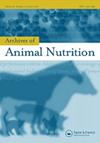口服13C-碳酸氢盐技术测定狗的能量消耗:影响呼吸商和13C恢复因子的饮食和环境因素
IF 1.5
3区 农林科学
Q1 AGRICULTURE, DAIRY & ANIMAL SCIENCE
引用次数: 0
摘要
口服13c -碳酸氢盐技术(o13CBT)可用于短期测量二氧化碳产量(RCO2)和能量消耗(EEx)。该方法依赖于对13C的呼吸商(RQ)和恢复因子(RF)的适当估计。选取4只猎犬进行4次实验,验证o13CBT对间接量热法(IC)的有效性,并确定RQ和RF;实验1:在维持(Mnt.)饮食中饲喂不同的蛋白质:脂肪:碳水化合物比例[占代谢能的百分比]:25:33:42;在开始测量(T0)的同时,高蛋白高纤维(HFibre)饮食中的38:26:36和高脂肪(HFat)饮食中的27:56:17;出口2:Mnt。餐后T0或4h (T4)日粮;出口3:T4在不同环境温度下,22℃和15℃;实验4:运动1小时后T4。RCO2和EEx是通过使用IC和o13CBT (o13CBTonline)同时进行的呼吸室测量来确定的,在实验1和2中,也连续两天使用o13CBT并将呼气收集到呼吸袋中(o13CBTbreathbags)。T0时得到的RQ值反映了饲粮组成,Mnt的最小二乘平均值(LSM)最高为0.954。高纤维组为0.905,高脂肪组为0.877 (p < 0.05)。试验2中,采食量与测量时间间隔的增加显著降低了RQ (p < 0.05), LSM在T0时为0.954,T4时为0.909。环境温度(实验3)和体力活动(实验4)对餐后RQ没有影响。饲粮对RF值无显著影响(exp . 1)。从T0开始测量的RF值(exp . 2)高于T4 (LSM分别= 0.971和0.836)(p < 0.05)。环境温度(实验3)不影响餐后RF。然而,当狗在测量前进行体力活动时(图4),RF值(LSM = 1.019)高于仅休息时(LSM = 0.836) (p < 0.05)。除实验1外,使用o13CBTbreathbags(460)测得的EEx值[kJ·kg BW-0.75·d-1]高于使用IC(421)和o13CBTonline(420)测得的EEx值(p < 0.05)。提供准确的RQ和RF值,o13CBTbreathbags可以作为一种独立的微创研究工具,在精心标准化的条件下测定狗的EEx。本文章由计算机程序翻译,如有差异,请以英文原文为准。
The oral 13C-bicarbonate technique for determination of energy expenditure in dogs: dietary and environmental factors affecting the respiratory quotient and 13C recovery factor
ABSTRACT The oral 13C-bicarbonate technique (o13CBT) can be used for short-term measurements of CO2 production (RCO2) and energy expenditure (EEx). The method relies on appropriate estimates for the respiratory quotient (RQ) and recovery factor (RF) of 13C. Four Retriever dogs were included in four experiments to validate the o13CBT against indirect calorimetry (IC), and determine RQ and RF; Expt. 1: feeding different protein:fat:carbohydrate ratios [in % of metabolisable energy]: 25:33:42 in a maintenance (Mnt.) diet; 38:26:36 in a high-protein high-fibre (HFibre) diet and 27:56:17 in a high-fat (HFat) diet, simultaneously with start of measurements (T0); Expt. 2: the Mnt. diet at T0 or 4 h postprandial (T4); Expt. 3: T4 at different ambient temperatures, 22°C and 15°C; Expt. 4: T4 after 1 h physical activity. The RCO2 and EEx were determined from the respiration chamber measurements made simultaneously with IC and the o13CBT (o13CBTonline), and in Expts. 1 and 2, also on two consecutive days using o13CBT with collection of breath into breath bags (o13CBTbreathbags). The RQ values obtained at T0 reflected dietary compositions, with the highest least square mean (LSM) of 0.954 for the Mnt. diet, 0.905 for the HFibre and 0.877 for the HFat diet (p < 0.05). An increased interval between meal and measurement period decreased RQ significantly (p < 0.05) in Expt. 2, LSM being 0.954 at T0 and 0.909 at T4. Ambient temperature (Expt. 3) and physical activity (Expt. 4) did not influence postprandial RQ. The RF values were not significantly affected by diet (Expt. 1). Measurements starting at T0 (Expt. 2) resulted in higher (p < 0.05) RF values than at T4 (LSM = 0.971 and 0.836, respectively). The ambient temperatures (Expt. 3) did not influence postprandial RF. However, when dogs were physically active prior to measurements (Expt. 4), RF values (LSM = 1.019) were higher (p < 0.05) than when resting only (LSM = 0.836). Calculations based on RQ and RF determined in each experiment resulted in RCO2 and EEx values which were not different regardless of method used, except for Expt. 1 where EEx-values [kJ · kg BW–0.75 · d–1] were higher (p < 0.05) when measured with o13CBTbreathbags (460) than by IC (421) and o13CBTonline (420). Provided accurate RQ and RF values, the o13CBTbreathbags can be used as an independent and minimally invasive research tool to determine EEx in dogs under carefully standardised conditions.
求助全文
通过发布文献求助,成功后即可免费获取论文全文。
去求助
来源期刊

Archives of Animal Nutrition
农林科学-奶制品与动物科学
CiteScore
3.90
自引率
5.00%
发文量
31
审稿时长
>24 weeks
期刊介绍:
Archives of Animal Nutrition is an international journal covering the biochemical and physiological basis of animal nutrition. Emphasis is laid on original papers on protein and amino acid metabolism, energy transformation, mineral metabolism, vitamin metabolism, nutritional effects on intestinal and body functions in combination with performance criteria, respectively. It furthermore deals with recent developments in practical animal feeding, feedstuff theory, mode of action of feed additives, feedstuff preservation and feedstuff processing. The spectrum covers all relevant animal species including food producing and companion animals, but not aquatic species.
Seldom can priority be given to papers covering more descriptive studies, even if they may be interesting and technically sound or of impact for animal production, or for topics of relevance for only particular regional conditions.
 求助内容:
求助内容: 应助结果提醒方式:
应助结果提醒方式:


